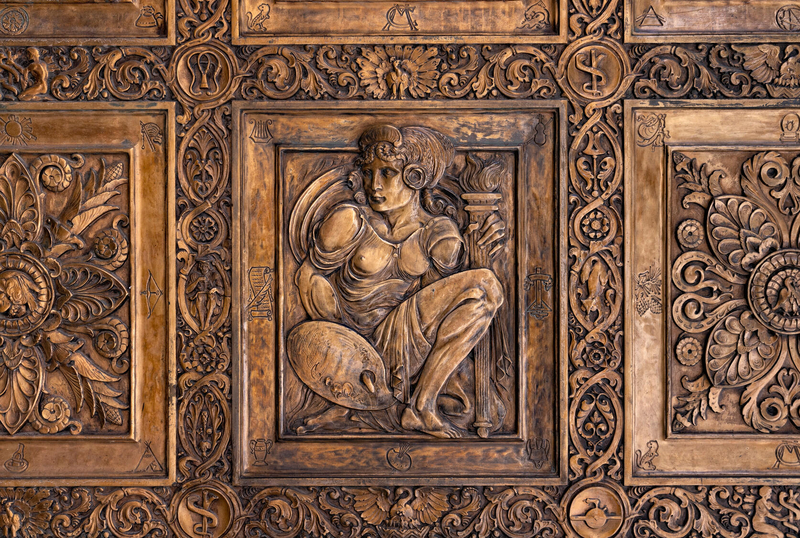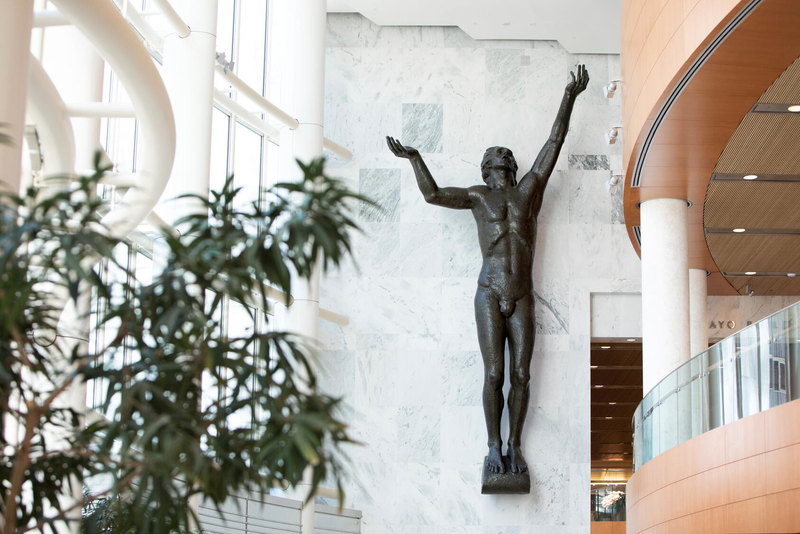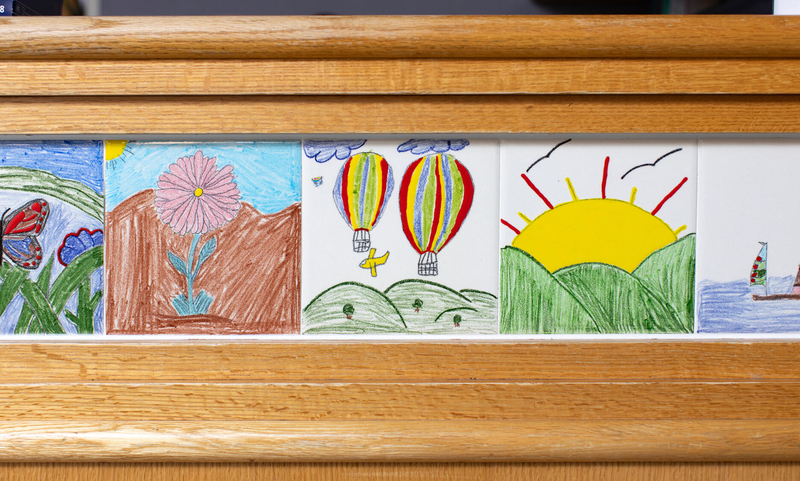Art through the ages: A history of art at Mayo Clinic
Mayo Clinic has a deep-rooted history of integrating the arts into its walls — both literally and figuratively — beginning with the 1914 Mayo Clinic building (which was replaced by the Siebens building in the 1980s). In its construction, the building’s architecture was fashioned with Rookwood tile and other aesthetic features, embodying the Mayo brothers’ belief that the building should be beautiful inside, and out, for staff and patients alike.
This belief continued with Henry Plummer, M.D., when constructing the Plummer Building in 1928. Artistic craftsmen were sought out to add intricacies to the building’s façade and woodwork. This took shape in the building’s sandstone carvings, hand-painted ceiling designs, iconic bronze doors and much more. And it was from these beautifully crafted structures that Mayo Clinic began implementing art into its DNA, values and Model of Care through the decades.

As Mayo Clinic began its rapid expansion in the 1950s, a more contemporary building design based on functional requirements was needed. However, there was concern that the building would take on a more sterile environment despite the use of top-quality building materials. To avoid this, the creation of an art program was proposed, ensuring that art forms be integrated with the architecture of the building. Samuel F. Haines, M.D. (I ’24), chair of the Mayo Clinic Board of Governors at the time, was assigned the task of establishing this “Art and Ornamentation Program”. With his direction, and professional advice from artists and architects alike, “centers of interest” were woven into the infrastructure of the diagnostic building. It was in these centers where various art forms were placed to be studied by patients and visitors while waiting on appointments and to create a pleasant working environment for Mayo Clinic staff.
It was in this first formal art program that the theme “Mirror to Man” was developed. While it was up to artists to interpret the theme, much of the work was done by Minneapolis sculptor, painter and art educator, Warren T. Mosman. His artistic philosophy “in all ages, man has made things first to be useful and then he made them beautiful” blended well with the desire to create a functional but aesthetically pleasing building. Because Mayo Clinic worked ntimately with people, Mosman believed that the art should be geared toward people. It was decided that the various artworks to be presented in the building should have varied approaches by different artists to the many phases of mankind’s living. Out of this came sub-themes of “Man and Home”, “Man’s Desire for Knowledge”, “Man and Companionship” and many others that complimented the overarching “Mirror to Man” theme.

With the themes in place, selected artists were invited to visit Rochester and received a copy of “The Doctors Mayo” by Helen Clapesattle to inspire their approach to the main and sub-themes. Initial sketches of the artworks were inspected and then approved by both the Building Committee and the Board of Governors. As construction progressed, so did the artwork, and it was eventually completed and positioned throughout the building. One of the building’s most well-known sculptures, “Man and Freedom”, was, at the time, positioned on the building’s north face. The 28-foot, 6,900-pound cast bronze sculpture by Croatian sculptor Ivan Mestrovic hung in that position for 44 years, until it was moved into the Nathan Landow Atrium of the Gonda Building in August 2000. Later, a series of four sculptures entitled “Man and Achievement” was added to the building’s east exterior wall. The series depicts various fields where one might express their creative drives and remains on that wall to this day.
In 1966, a nine-floor extension to the Mayo Building was approved. With this approval, it was agreed that Mayo Clinic Alumni the art program launched in 1953 should continue. Again, a committee was formed to approve another art installation — “Man and Recreation” — to be added to the building’s south wall. However, once this was completed, the art committee disbanded in an official capacity, with informal discussions surrounding art continuing. Through the help of various consultants, it was agreed that Mayo Clinic had a need for a formal art program, prompting the creation of the Mayo Foundation Art Program in the early 1970s.

With the creation of this formal art program came changes to how art was acquired and presented at Mayo Clinic. The “Mirror to Man” theme was now seen as too restrictive and was discontinued in favor of a pluralistic program. It was agreed that acquired art should look to the past as well as the future while integrating other mediums such as sculpture, paintings, graphics, abstract art and more. Acquisition of art also focused on contemporary pieces, making it more budget friendly. In addition, Mayo Clinic accepted art pieces from generous donors, and continues that practice presently.
The implementation of art didn’t stop at Mayo Clinic in Rochester, Minnesota. Both Mayo Clinic campuses in Arizona and Florida feature art throughout their buildings, as well as hospitals that are part of the Mayo Clinic Health System. For example, Luther Hospital in Eau Claire, Wisconsin, a part of the Mayo Clinic Health System — Northwest Wisconsin region, acquired more than 300 pieces of art in the 1990s. This collection featured works by regional artists — a practice continued by Mayo Clinic at its various locations. The hospital also featured art by children on the pediatrics floor — much of which was acquired at an area-wide children’s art show. This process was also incorporated on the Saint Marys Campus of Mayo Clinic Hospital in Rochester, Minnesota, in the form of artwork from 9,000 southeast Minnesota school children that could be reproduced on ceramic tiles.

Today, Mayo Clinic persists in its goal of enhancing the medical environment into one that provides an uplifting, comforting nature. Mayo Clinic displays donations of specific artwork — such as the 13 Chihuly chandeliers in the Gonda Building and the Andy Warhol Endangered Species Series — and uses funding to commission works for its locations. In addition, the displayed artworks are highly diverse in terms of artists’ backgrounds, subjects, materials and media — aligning with Mayo Clinic’s commitment to multicultural respect.
The various artworks are also accompanied by live music and related events available for Mayo patients, visitors and staff alike. Art booklets are provided at welcome desks providing an in-depth exploration of Mayo’s art history. In addition, volunteers at the Rochester campus provide hour-long art tours Monday through Friday for patients, caregivers and staff. For every creative interest, there is something to be enjoyed by all. By striving to serve patients and visitors in a very understanding, human way, Mayo Clinic has created an environment that reflects its dedication to providing compassionate care while complimenting the efforts of all Mayo Clinic staff.
This article appeared in issue two of our 2024 Mayo Clinic Alumni Magazine. Read the full issue and see more art pieces here.